LX-5024 - Rotating and Static Xenon Testers Compared
Technical Bulletins
Posted 2023
Last Updated 2023
LX-5024
Conclusions From This Study
- The within-chamber uniformity of degradation for the Atlas rotating drum speci - men mounting systems tested varied from ±3% to ±13% - depending on the type of material and exposure conditions.
- The uniformity for the Q-SUN Xe-3 flat array specimen mounting system with manual repositioning varied from ±3% to ±8%.
- The flat array chamber gave better uniformity than the rotating drum in some cases, and the rotating drum was better for others.
- The uniformity of degradation within the flat array chamber was worse when the specimens were not repositioned during the test. This was to be expected and is why manual repositioning is recommended. However, even without repositioning, this flat array chamber produced as good or better uniformity than the rotating drum for some material/exposure conditions.
Abstract
It’s desirable that all the specimens exposed together in a single xenon test chamber are subjected to substantially similar conditions. This is a study of how well this is achieved in two different types of chambers - a rotating drum and an advanced static specimen mounting system. This was done by measuring the uniformity of degradation of multiple replicates of a particular material. Four different materials were used; polystyrene, blue wool L2, blue wool L4, and an alkyd-melamine coating. Each is a standard reference material used in standard test methods to verify that the xenon test chamber is operating properly. The materials were exposed to the test conditions described in SAE J2527, SAE J2412, or AATCC 16. A total of 6 labs participated in the study.
Background
Historically, the majority of xenon test chambers have had a lamp in the center and a cylindrical specimen mounting rack around the lamp which rotates the test specimens as shown in figure 1. This specimen mounting system is frequently described as a “rotating drum”. More recently, xenon testers have been introduced with a static, flat plane specimen mounting system as shown in Figure 2.
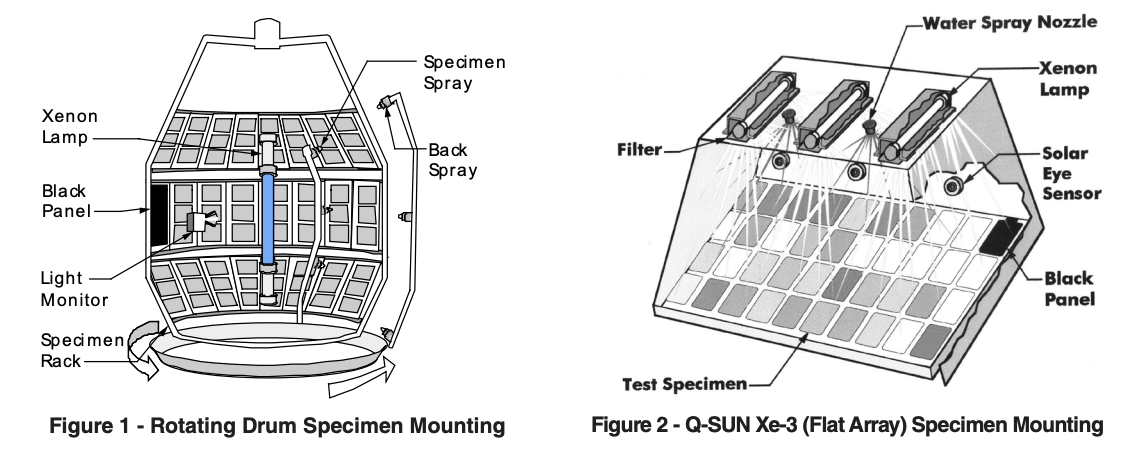
One of the design goals of both types of chambers is to produce uniform irradiance, temperature, and humidity throughout the chamber. In reality, though, it’s not possible to produce perfect uniformity. To compensate for this, the test specimens are repositioned (automatically or manually) during the test so they see the same conditions. The rotating drum does this repositioning automatically in one dimension – horizontally around the lamp. The rotating drum does not, however, compensate for variations in irradiance, temperature, and humidity in the vertical direction. The static flat plane specimen mounting system requires manual repositioning at regular intervals. There are various ways in which this can be done. The method used in this paper takes less than one minute per day.
Purpose
Prior work has shown that rotating drum and flat array type xenon test chambers produce similar types and similar rates of degradation on a wide variety of materials, e.g. plastics, paints, textiles, printing inks. The purpose of this paper is to focus on the uniformity of degradation of test specimens within an individual chamber of either type.
Test Procedure
The uniformity of degradation was determined by exposing multiple replicates of a material in a chamber and measuring the amount of degradation on each replicate. Between 9 and 108 replicates were used, depending on the space available in the chamber and the cost to run the test. The materials, chamber types, specimen mounting, exposure conditions, exposure times, degradation measurements, and cooperating labs are described below. Materials. Three types of materials were used; polystyrene, blue wool (two types), and an alkydmelamine coating. These materials were chosen because they are standard reference materials and they are significantly different from one another. Polystyrene: This is a clear plastic lightfastness standard required for the SAE J1960 and J1885 automotive test methods. Its mode of degradation is yellowing. This material is sensitive to variations in temperature and irradiance. The specimen size is 50 mm x 75 mm x 3 mm thick and is available from Test Fabrics Inc. All the specimens used in this study were from lot 6.
Blue Wool L2: This is a blue dyed wool fabric lightfastness standard required for AATCC textile Test Method 16 . Its mode of degradation is fading. This material is sensitive to variations in temperature, relative humidity, and irradiance. The specimen size was 50 mm x 100 mm and is available from the American Association of Textile Chemists and Colorists. All the specimens used in this study were from lot 8. Blue Wool L4: This is also a blue dyed wool fabric very similar to the L2 blue wool except that the L4 is darker and more light stable. L4 fades at about one quarter the rate of L2. The specimen size was 50mm x 100mm and is available from the American Association of Textile Chemists and Colorists. All the specimens used in this study were from lot 5. Alkyd-Melamine Coating: This is a clear coating applied over a gray base coat on a steel substrate. It is a standard reference material recommended for use in the VDA 621-430 Cracking Resistance of Clear Coats test method. This material is similar to an automotive clear coat, but intentionally formulated to crack in a relatively short time . It is sensitive to variations in temperature, irradiance, and time of wetness. The specimen size is 75 mm x 75 mm x 0.8 mm and is available from BASF Coatings AG. Chamber Types. Rotating Drum: Rotating drum type chambers have been in use since World War I. The models used in this study were the Ci5000, Ci4000, and Ci65A Weather-Ometers® made by Atlas Material Test Solutions. These models were chosen because they are commonly used in the industry and because the Ci5000 and Ci4000 are the latest rotating drum models available. They each control irradiance, black panel temperature, chamber air temperature, and relative humidity. They have a patented system for controlling temperature and relative humidity7, 8, 9, 10. Each of the chambers used in this study utilized three tier racks which were introduced in the 1980’s to improve irradiance uniformity. A total of five different rotating drum chambers were used; one Ci5000, one Ci4000, and three Ci65’s. Flat Array: The flat array chambers used in this study were the Q-SUN® Xe-3-HS tester made by Q-Lab Corporation. This model of flat array tester was chosen because it also controls the complete range of critical test parameters -- irradiance, black panel temperature, chamber air temperature, and relative humidity. It has three xenon lamps with a patented power supply, and a patented irradiance control system. The reflective walls of the chamber and the internal reflectors on the lamp housings are designed to maximize uniformity of irradiance and produce diffuse light like natural sunlight. It has a patented system for controlling temperature and relative humidity, as well as specially designed ducting and airflow to promote uniformity. A total of five different Q-SUN Xe-3-HS chambers were used. Specimen Mounting. Rotating Drum: Three specimen holders were filled with three specimens each. One was placed in the top tier, one in the middle tier, and one in the bottom tier as shown in figure 3. This placed 9 replicates in a vertical plane one above the other. For those tests where more than 9 replicates were used, the additional replicates were mounted in a similar manner but in a different position around the drum. Specimen holders filled with other test materials (not related to this test) or blank panels were placed in the other positions around the rotating drum. The polystyrene and automotive clear coat materials were mounted with no backing material and the blue wool materials were mounted with a white card stock backing as recommended in AATCC test method 16.
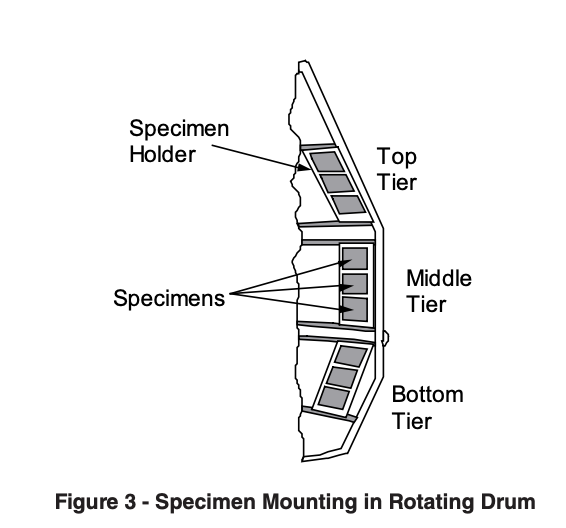
Flat Array: Specimens were mounted on four minitrays that can hold up to fourteen 50mm x 100mm specimens each. The mini-trays were then placed on the flat tray inside the chamber. The polystyrene and clear coat materials were mounted with no backing material and the blue wool materials were mounted with white card stock backing and placed in textile mounting frames. Specimen repositioning is recommended in flat array chambers. Therefore, one set of tests was run with repositioning and one set without repositioning to show its effect. Tests run with repositioning were repositioned once a day as shown in figure 4.
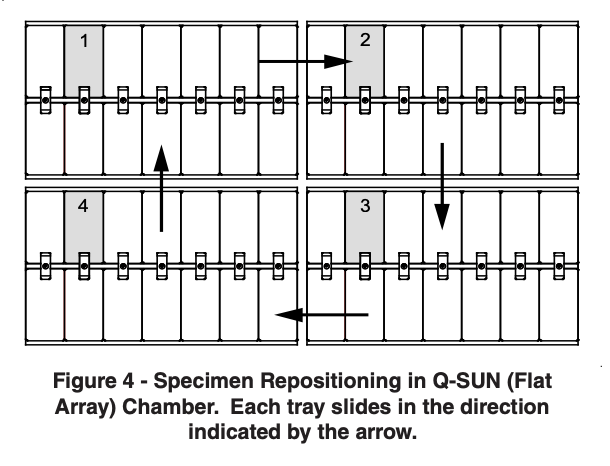
The numbers 1, 2, 3, 4 shown in figure 4 indicate the position of one specimen on day 1, day 2, day 3, and day 4 of the test. This specimen would continue to rotate between these four positions as the test proceeded beyond four days. This method of repositioning took less than one minute per day. The one exception to this was that when the L2 blue wool specimens were repositioned they were moved two positions instead of one because they were exposed for such a short time (either 20 or 24 hours). There are, conceivably, many other repositioning methods possible and some may produce more uniform degradation by rotating the specimens in a greater variety of positions. This was not investigated in this paper but would make for an interesting follow up study. Exposure Conditions. SAE J252716 : This test method, published by the Society of Automotive Engineers, is intended for testing automotive exterior components. It is the performance based version of SAE J1960. It utilizes a xenon lamp with an “Extended UV” filter to transmit wavelengths which are shorter than those which occur in natural sunlight. The reason for this is that these short wavelengths typically accelerate the rate of degradation. This test method subjects test specimens to light and dark periods, as well as wet and dry periods. It controls the irradiance at 340 nm. The specific test cycle is listed in Table 1.

SAE J241217: This test method is intended for testing automotive interior components. It is the performance based version of SAE J1885. It also utilizes a xenon lamp with an “Extended UV” filter to transmit wavelengths which are shorter than those which occur in natural sunlight. This test method subjects test specimens to light and dark periods with no water spray. It controls the irradiance at 340 nm. The specific test cycle is listed in Table 2.
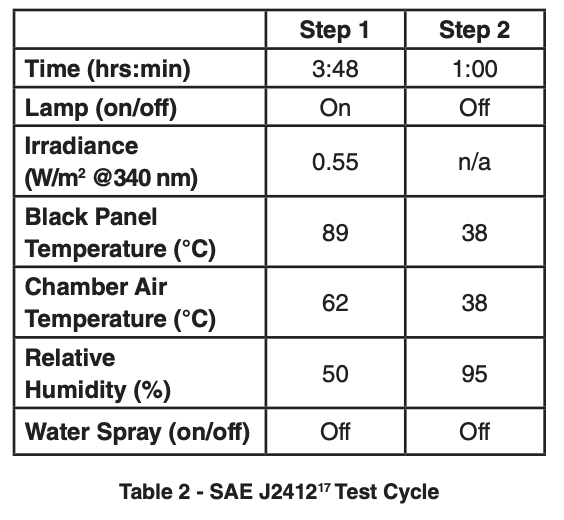
AATCC Method 16: This standard, published by the American Association of Textile Chemists and Colorists, is intended for testing textile materials. It utilizes a xenon lamp with a window glass filter to transmit wavelengths typical of sunlight through standard household windows. This test method subjects test specimens to continuous light as shown below. It controls the irradiance at 420 nm.
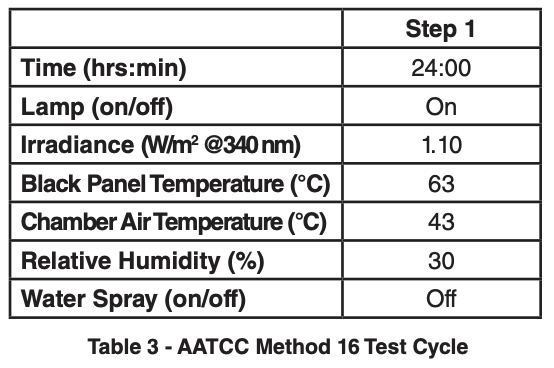
Exposure time
The exposure time varied depending on the material. The least durable material (blue wool L2) was exposed for the least amount of time (20 hours) and the most durable material (automotive clear coat) for the longest time (up to 500 hours). This allowed significant, but not excessive, degradation to occur on each material. Degradation Measurements. Color Measurements: Initial and final color measurements were taken of the polystyrene and blue wool materials. The color measurements were taken using an integrating sphere spectrophotometer in the reflectance mode. The CIELAB color scale was used with a D65 illuminant, 10º observer, large area view, specular component included, and UV component included. Delta b* readings were used for the polystyrene and delta E* readings were used for the blue wool materials. Since the polystyrene is clear, it was backed with a white calibration tile during the color measurements. Likewise, since the blue wool is woven, it was backed with another piece of blue wool. Also, since the blue wool has directionality, two color measurements were taken 90º apart and averaged. The blue wool was conditioned at standard conditions for four hours prior to taking all color measurements. Cracking: The automotive clear coat material was inspected for cracking several times a day. When 10 cracks were found on the surface of a specimen, that specimen was removed from the chamber and the exposure time recorded. The test was then continued with the rest of the specimens until 10 cracks developed on all the replicates in the chamber. Cooperating Labs. A total of six laboratories participated in the study: three testing labs of paint manufacturers, two independent testing labs accredited by A2LA, and one manufacturer of test equipment. All six labs have many years of experience with xenon arc testing.
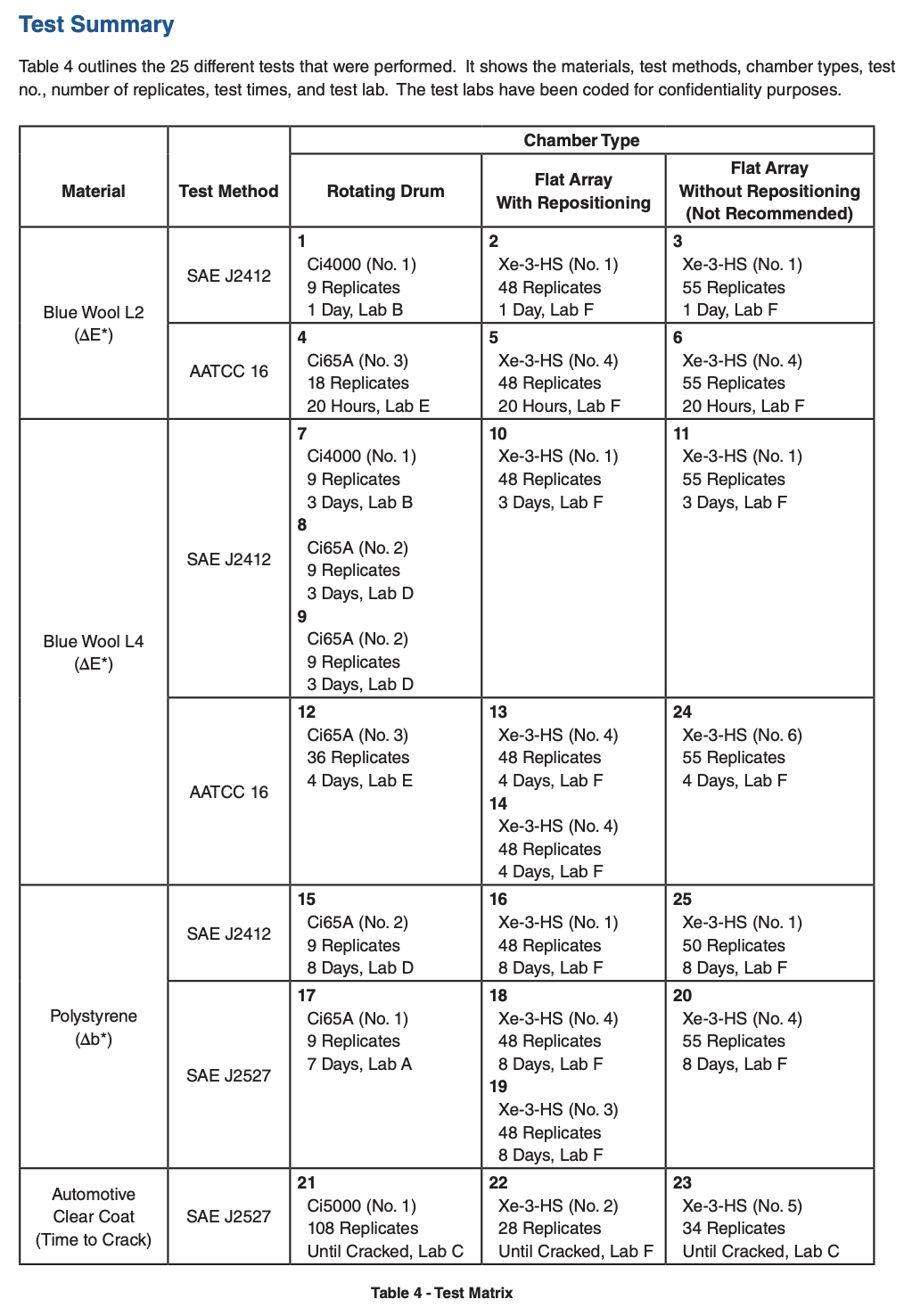
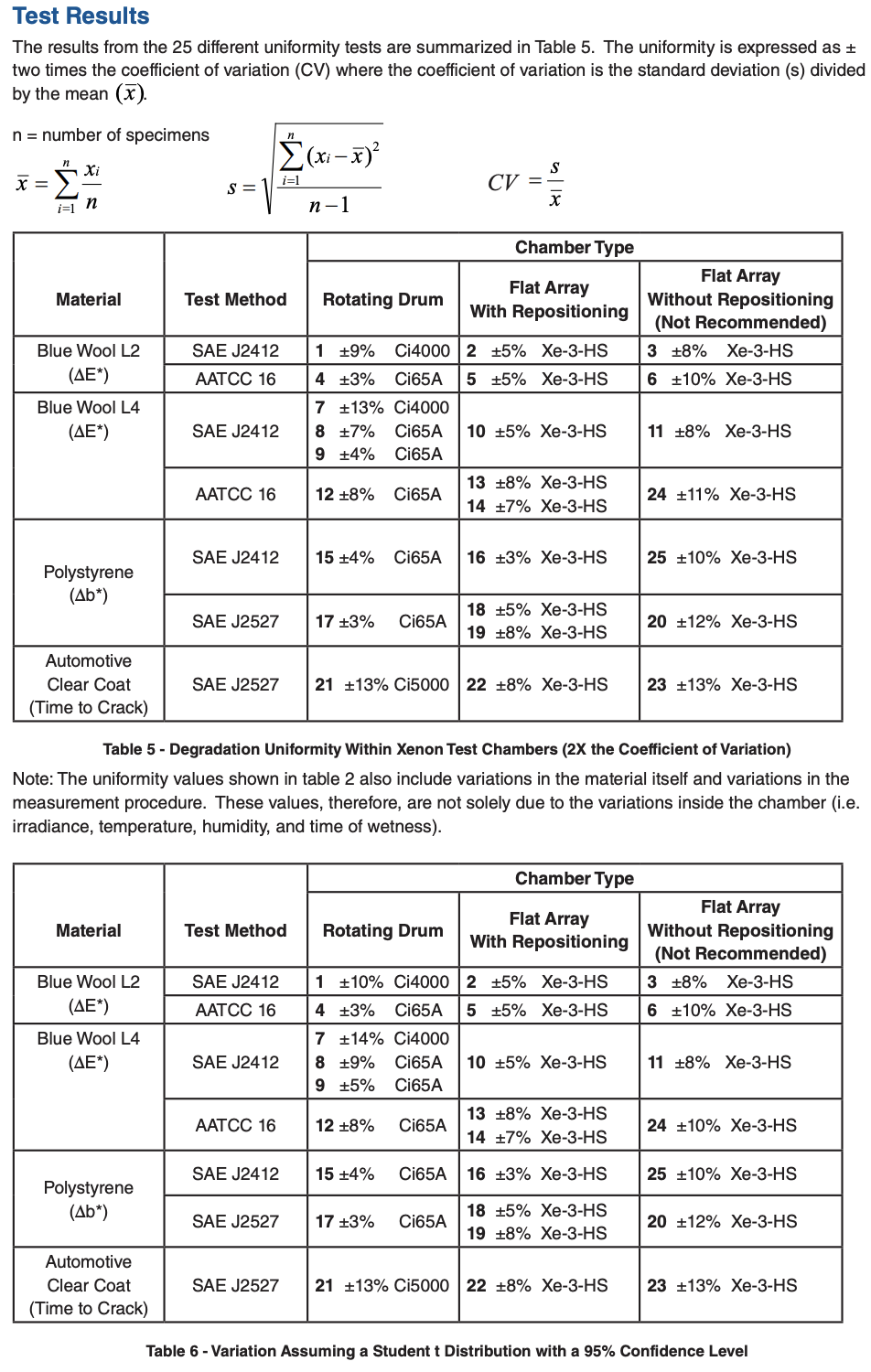
Conclusions
1) The within-chamber uniformity of degradation for the rotating drum specimen mounting system varied from ±3% to ±13% - depending on the type of material and exposure conditions. 2) The uniformity for the Q-SUN Xe-3 flat array specimen mounting system with manual repositioning varied from ±3% to ±8%. 3) The flat array chamber gave better uniformity than the rotating drum in some cases, and the rotating drum was better for others. 4) The uniformity of degradation within the flat array chamber was worse when the specimens were not repositioned during the test. This was to be expected and is why manual repositioning is recommended. However, even without repositioning, this flat array chamber produced as good or better uniformity than the rotating drum for some material/exposure conditions.
Recommendations
The degradation uniformity of test specimens exposed in xenon test chambers is good - but not perfect. Therefore, in order to make accurate decisions on the relative durability of different materials, the authors feel it is best to (a) test multiple replicates (three minimum) of each material and average the results, and (b) manually reposition specimens in both rotating drum and flat array chambers according to a planned schedule.